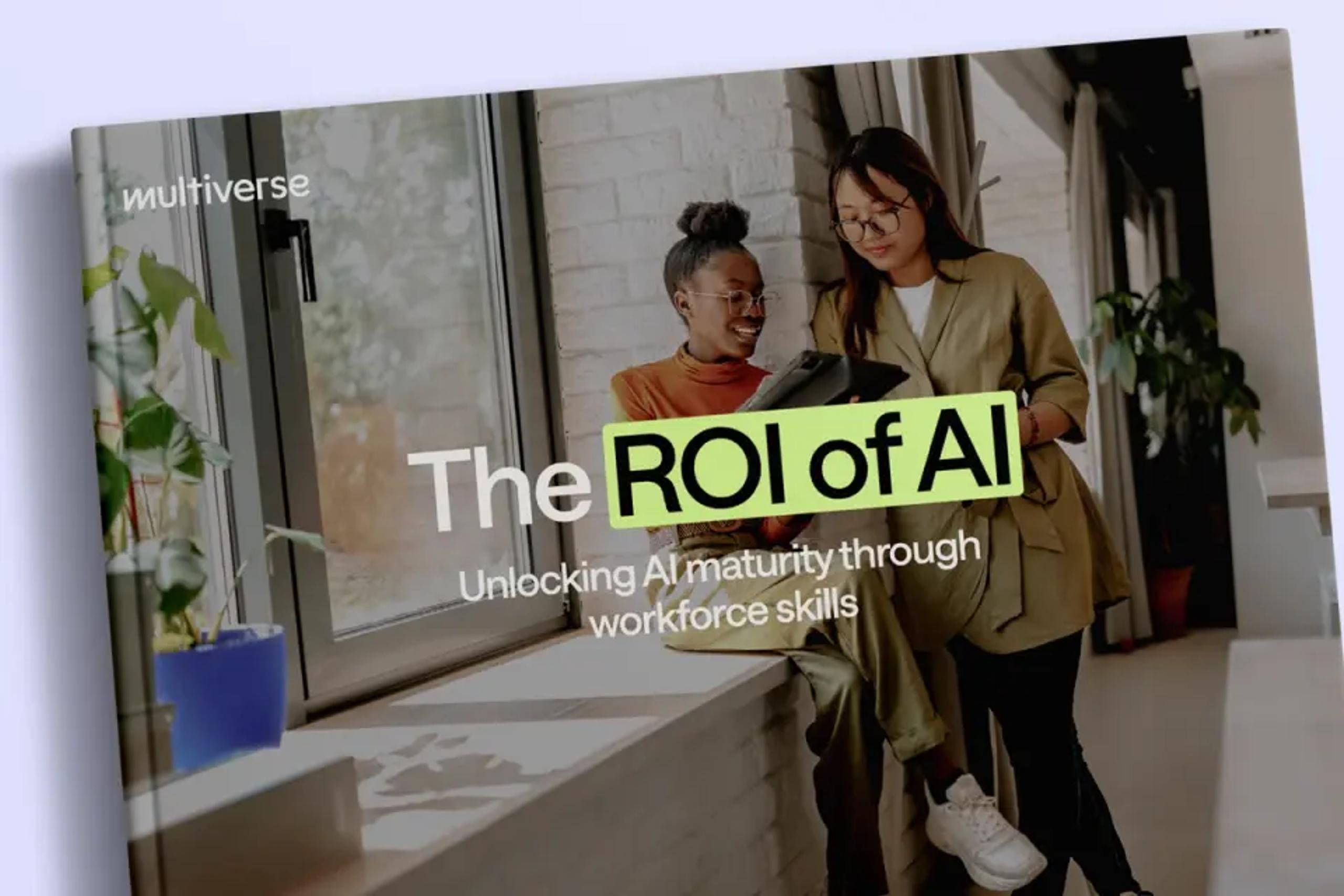Take a good look around and you'll notice you are surrounded by data.
From our daily banking activities to our most intimate medical records, digital tools are as commonplace as your morning cuppa. Problem is, there simply isn't enough talent to keep up with it.
According to the latest research:
- An estimated 133 million new roles may emerge globally by 2022 as a result of the new division of labour between humans, machines and algorithms(opens new window).
- Within the next 10 to 20 years, 90% of jobs(opens new window) will require some sort of digital skills.
- Roughly 37% of workers in Europe don’t have basic digital skills(opens new window).
It's not difficult to see that there is an ever-growing gap between the in-demand skills of the future and the abilities of the current workforce. By some estimates, this gap could cost the UK a whopping £141 billion in GDP growth(opens new window).
But for forward-thinking business, there's a major opportunity hidden in the digital skills gap "crisis". With the right approach to employee learning and development, you can beat the odds and stay ahead of the game. Let's take a closer look.
Table of contents
1. What is the digital skills gap? And how can use it to your advantage.
2. How to futureproof your talent strategy and beat the digital skills gap
3. Invest in upskilling and reskilling
4. Foster intrapreneurship
5. Go diverse with apprenticeships
6. Give, get, and fill the gap
What is the digital skills gap? And how can use it to your advantage.
Between automation, AI and all types of bots, there's a lot that can be said about the digital skills gap.
In short, the digital skills gap is the lack of digital skills in the existing workforce compared to the current and projected demand for growth in technological industries.
And it's got more than a few businesses on their toes.
According to the 2019 PWC CEO Survey, 79% of UK-based CEOs(opens new window) see the availability of key skills as a top business threat that will impact their growth prospects in the next 12 months. That's largely because, when you don't have the technical talent you need, revenue-generating innovation takes a hit, while workforce costs escalate.
"Companies are unable to pursue growth opportunities, key initiatives are cancelled and quality standards can slip," say the report's authors.
But that doesn't mean today's CEOs are going to lie back and let their businesses waste away. Many of today's best and brightest companies are taking it upon themselves to bring their workforce up to date.
“Skills really matter the most,“ Facebook’s vice president of human resources, Janelle Gale tells CNBC Make It.(opens new window) Maybe that's why, according to Lloyds Bank UK Consumer Index(opens new window), the number of people in the UK who lack basic digital skills is slowly, but surely declining.
Of course, with an estimated 10.7 million UK adults having few to no digital skills, there's still plenty of work to be done.
That's where having the right talent strategy can make all the difference.
How to futureproof your talent strategy and beat the digital skills gap
If you're ready to look the digital skills gap in the face, we've got good news:
Your employees are right there with you.
74% of people surveyed in PWC’s Workforce of the Future(opens new window) report said they were ready to learn new skills or re-train to remain employable in the future, proving that modern, relevant skills are on everyone's wish list, not just employers'.
But with traditional employee training methods proving all but futile, what can you do to really move the needle?
Here are a few ways to create a holistic approach to growing and retaining the digital-savvy talent you need in order to succeed.
Invest in upskilling and reskilling
In the not-so-distant future, humans will regularly live to 100(opens new window).
As people work longer and retire later, they'll witness multiple transformations in job skills and requirements, making retraining the rule—not the exception.
With this kind of paradigm shift looming just around the corner, companies can no longer afford to fall back on ‘just-in-case' approaches to training and development.
If you want to stay ahead of the curve, you're going to need a whole new strategy.
Many leading companies are already making upskilling a routine part of the business.
- Heineken offers a career track tool(opens new window) to help it's global workforce of 80,000 employees move laterally within the organization by listing out the opportunities that fit with employees' personal aspirations and including helpful information on how best to prepare for a role.
- At Italian telecommunications company Fastweb, a newly launched rotational development program helps increase internal mobility for employees, while empowering the talent acquisition team with more fuel for employee attraction and retention.
- Christie's of London regularly teaches new and existing employees fresh skills through employee apprenticeships, including 1:1 coaching sessions, e-classroom lessons, mini experiments and insight days.
Laura Tomsett is the Recruitment Advisor at Christie’s. When she took on the role, she had no experience in the type of recruitment projects an organisation like Christie's would require.
“A significant portion of my role involves me delivering recruitment projects; having had no formal training in this area, I felt it would be invaluable to my development to embark on a project management qualification," says Laura.
A clear and structured reskilling or upskilling strategy opens up your talent pool to stellar candidates that are a great culture fit, but may need a little help learning role-specific skills.
Foster intrapreneurship
Traditionally, many companies have responded to talent gaps by employing people from other sectors or accessing the gig economy. Unfortunately, that's no longer enough.
One clear factor fuelling the shift, is the increase in young people wanting to run their own business. According to a study by Idinvest Partners, 76% of millennials(opens new window) want to start their own business in the future and many Boomers(opens new window) and older workers also have entrepreneurial goals.
But that doesn't mean you shouldn't try to win them for your team.
With the right approach to intrapreneurship(opens new window), you can help shape an entire generation of entrepreneurs while simultaneously filling the gaps in your org.
Here's how to do it:
- Encourage experimentation and support it with a failure-friendly(opens new window) environment.
- Create opportunities for intrapreneurship by actively seeking employee innovation.
- Offer support for commercially viable ideas within the company.
For some companies, this may feel like a big leap to take. But if you think about it, what have you got to lose?
By saying goodbye to the old rank-and-file and putting a little more trust in your employees, you might end up with the next big, profit-driving idea—and an intensely loyal workforce.
"I've gone from basic data management to essentially running the research part of our team, which I really enjoy," says Robert Cowper-Coles, apprentice at Newable(opens new window). "If you think back to where I was a year ago, it's like black and white. I'm working as hard as I can because I enjoy my job and that's the best feeling."
Go diverse with apprenticeships
There's a growing body of evidence supporting the case for diversity as a driving factor for business resilience.
In fact, according to a McKinsey report(opens new window), companies in the top quartile for gender or racial and ethnic diversity are more likely to have financial returns above their national industry medians.
No matter which way you cut it, apprentices bring a diverse range of fresh new skills and perspectives to the business.
Here's how apprenticeships work:
- Apprentices work within, and learn from, your business. They spend 20% of their time doing off the job training, normally provided in partnership with a training provider.
- You can tailor an apprentice’s training to fit your business needs using government funding to cover a significant percentage of the costs.
- For SMEs specifically, 95% of training costs can be covered.
Apprentices get real experience and a guaranteed salary, while employers get a fresh injection of talent. It's a true win-win.
If you're thinking that apprenticeships aren't a fit for your business, think again. Today's apprenticeships look very different than they used to, covering a range of important digital areas including research, marketing and finance.
If you can think of it, there’s probably an apprenticeship available. From large corporations to agile startups, businesses of all shapes and sizes are taking advantage of the many diversity benefits of this largely untapped pool of talent.
Give, Get, and Fill the Gap
With the Fourth Industrial Revolution in full swing, it's time to give your employees the support they deserve.
As technology continues to have a growing influence on our lives, it won't just be technical skills like coding and programming that matter. Deeply human abilities like creative thinking, problem-solving and negotiating will take centre stage. By choosing to focus on continuous, life-long education and training, you can position your company for future achievement, while doing the same for your employees.
And that's important, because when it comes to the success of your business, nothing is more essential than the success of your people.




